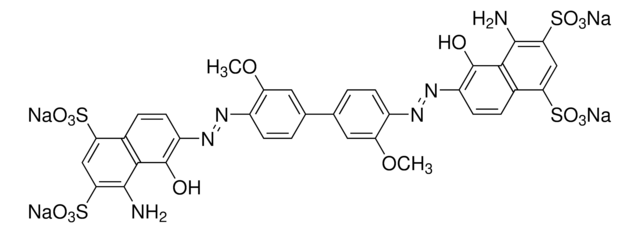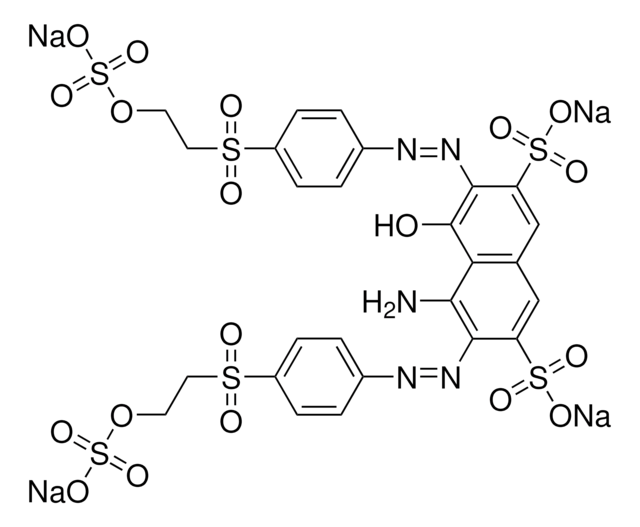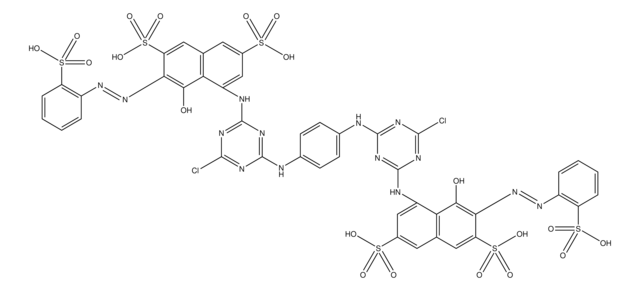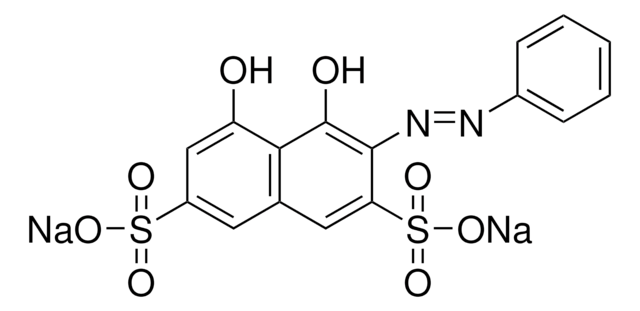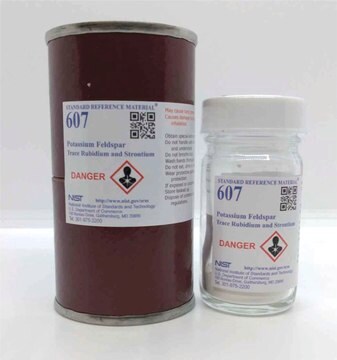D2535
Direct Blue 15
suitable for Histopaque® system, Powder
About This Item
Produits recommandés
Nom du produit
Direct Blue 15, suitable for Histopaque® system, suitable for viability studies of collagenase-treated rat liver cells
Description
suitable for Histopaque® system
Niveau de qualité
Forme
powder
Composition
Dye content, ~44%
Couleur
dark blue
Solubilité
water: 10 mg/mL, clear, blue
Adéquation
suitable for viability studies of collagenase-treated rat liver cells
Application(s)
diagnostic assay manufacturing
hematology
histology
Température de stockage
room temp
Chaîne SMILES
[Na+].[Na+].[Na+].[Na+].COc1cc(ccc1N=Nc2c(O)c3c(N)cc(cc3cc2S([O-])(=O)=O)S([O-])(=O)=O)-c4ccc(N=Nc5c(O)c6c(N)cc(cc6cc5S([O-])(=O)=O)S([O-])(=O)=O)c(OC)c4
InChI
1S/C34H28N6O16S4.4Na/c1-55-25-9-15(3-5-23(25)37-39-31-27(59(49,50)51)11-17-7-19(57(43,44)45)13-21(35)29(17)33(31)41)16-4-6-24(26(10-16)56-2)38-40-32-28(60(52,53)54)12-18-8-20(58(46,47)48)14-22(36)30(18)34(32)42;;;;/h3-14,41-42H,35-36H2,1-2H3,(H,43,44,45)(H,46,47,48)(H,49,50,51)(H,52,53,54);;;;/q;4*+1/p-4
Clé InChI
OLSOUGWNONTDCK-UHFFFAOYSA-J
Vous recherchez des produits similaires ? Visite Guide de comparaison des produits
Application
Informations légales
Mention d'avertissement
Danger
Mentions de danger
Conseils de prudence
Classification des risques
Carc. 1B
Code de la classe de stockage
6.1C - Combustible acute toxic Cat.3 / toxic compounds or compounds which causing chronic effects
Classe de danger pour l'eau (WGK)
WGK 3
Point d'éclair (°F)
Not applicable
Point d'éclair (°C)
Not applicable
Listes réglementaires
Les listes réglementaires sont principalement fournies pour les produits chimiques. Seules des informations limitées peuvent être fournies ici pour les produits non chimiques. L'absence d'indication signifie qu'aucun des composants n'est répertorié. Il incombe à l'utilisateur de s'assurer de l'utilisation sûre et légale du produit.
EU REACH Annex XVII (Restriction List)
Faites votre choix parmi les versions les plus récentes :
Certificats d'analyse (COA)
Vous ne trouvez pas la bonne version ?
Si vous avez besoin d'une version particulière, vous pouvez rechercher un certificat spécifique par le numéro de lot.
Déjà en possession de ce produit ?
Retrouvez la documentation relative aux produits que vous avez récemment achetés dans la Bibliothèque de documents.
Les clients ont également consulté
Notre équipe de scientifiques dispose d'une expérience dans tous les secteurs de la recherche, notamment en sciences de la vie, science des matériaux, synthèse chimique, chromatographie, analyse et dans de nombreux autres domaines..
Contacter notre Service technique

